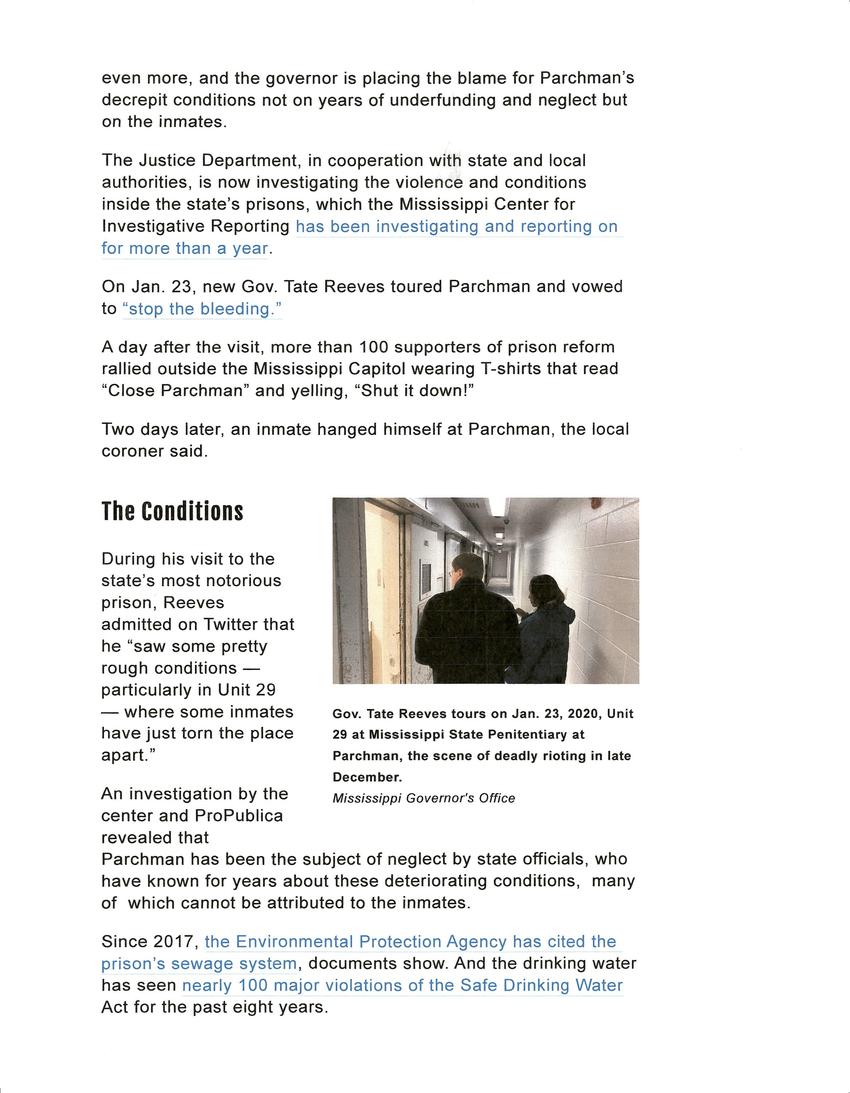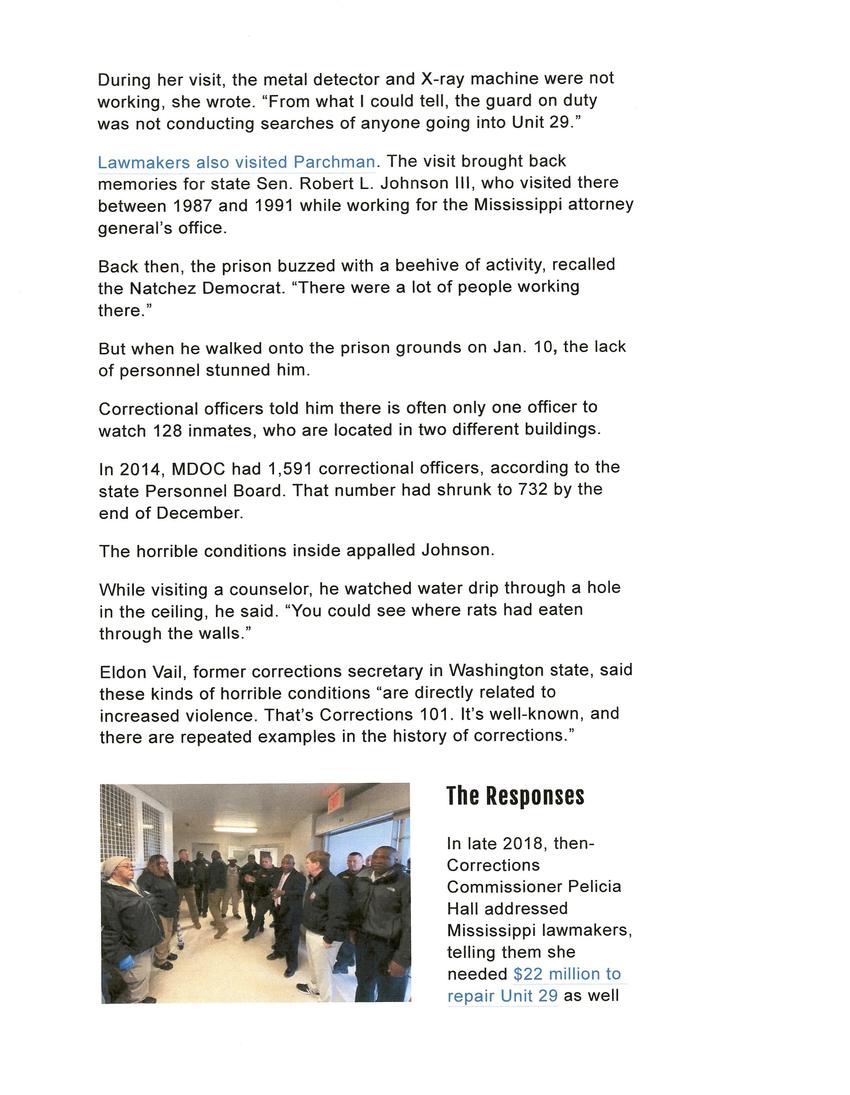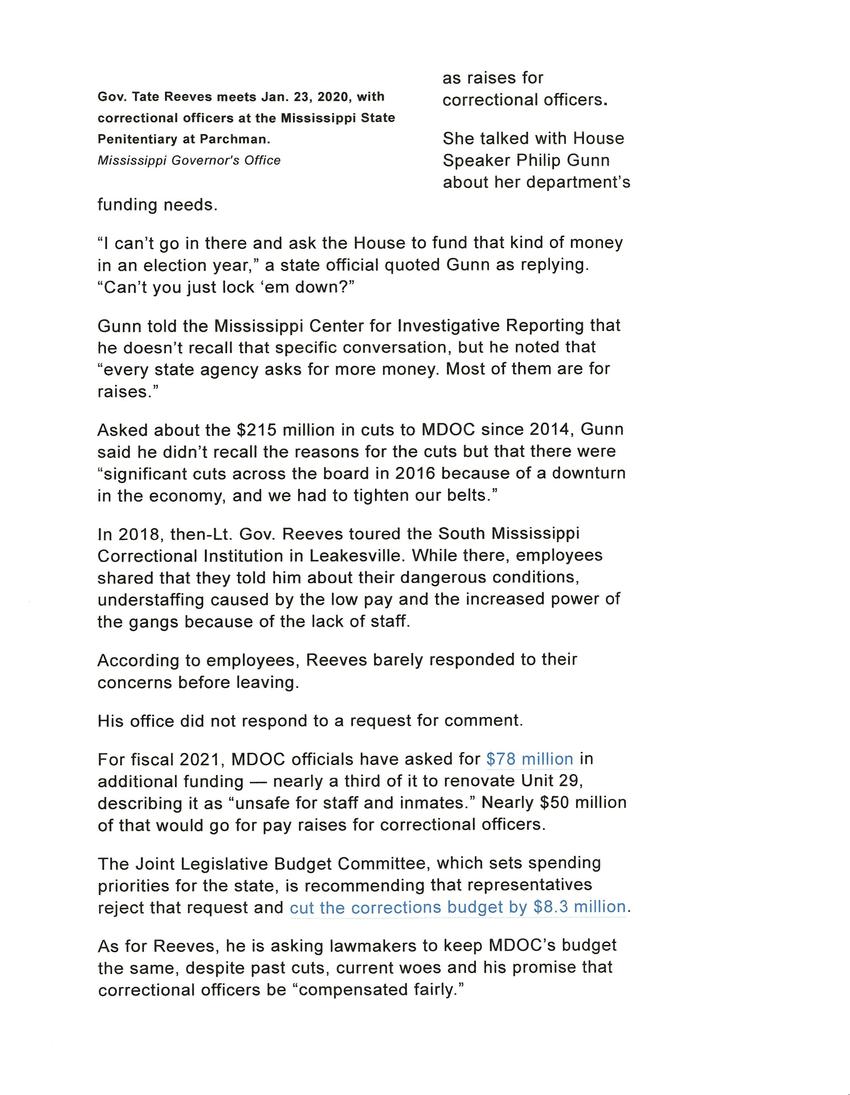
Transcription
https://www.mississippicir.org/news/anatomy-of-a-disaster
Anatomy of a Disaster
February 3, 2020
With 16 violent deaths, Parchman sees “level of violence and lethality that we associate with prisons in countries like Brazil and Honduras.”
Gov. Tate Reeves visits on Jan. 23, 2020, the shuttered Walnut Grove Correctional Facility, a private prison originally designed to house juvenile felony offenders and now being eyed to house inmates for maximum-security inmates.
Mississippi Governor's Office
LOCKED DOWN
By Jerry Mitchell
Mississippi Center for Investigative Reporting
State leaders and lawmakers oversaw the gutting of the Mississippi Department of Corrections’ budget by $215 million over the past six years.
And now they must oversee the future of funding Mississippi’s prisons, one of which is imploding.
Over the past nine months, the Mississippi State Penitentiary at Parchman has seen at least 16 violent deaths, joining the ranks of some of the world’s deadliest prisons per capita. Those deaths include eight suicides and eight homicides. A ninth possible homicide is still being investigated, according to the coroner and state Crime Lab.
“This is a level of violence and lethality that we associate with prisons in countries like Brazil and Honduras, not the United States,” said David Fathi, director of the ACLU National Prison Project.
State officials’ immediate responses included shuffling some inmates to a long-shuttered unit lacking running water and lights, busing others classified as maximum security to a private prison holding out-of-state prisoners from Vermont, and examining the relocation of these super-max inmates to a closed private prison originally designed to house juvenile felony offenders.
The state Legislature is now deciding how to give MDOC, which the Joint Legislative Budget Committee has recommended cutting even more, and the governor is placing the blame for Parchman’s decrepit conditions not on years of underfunding and neglect but on the inmates.
The Justice Department, in cooperation with state and local authorities, is now investigating the violence and conditions inside the state’s prisons, which the Mississippi Center for Investigative Reporting has been investigating and reporting on for more than a year.
On Jan. 23, new Gov. Tate Reeves toured Parchman and vowed to “stop the bleeding.”
A day after the visit, more than 100 supporters of prison reform rallied outside the Mississippi Capitol wearing T-shirts that read “Close Parchman” and yelling, “Shut it down!”
Two days later, an inmate hanged himself at Parchman, the local coroner said.
Gov. Tate Reeves tours on Jan. 23, 2020, Unit 29 at Mississippi State Penitentiary at Parchman, the scene of deadly rioting in late December. Mississippi Governor's Office
Gov. Tate Reeves tours on Jan. 23, 2020, Unit 29 at Mississippi State Penitentiary at Parchman, the scene of deadly rioting in late December.
Mississippi Governor's Office
The Conditions
During his visit to the state’s most notorious prison, Reeves admitted on Twitter that he “saw some pretty rough conditions — particularly in Unit 29 — where some inmates have just torn the place apart.”
An investigation by the center and ProPublica revealed that Parchman has been the subject of neglect by state officials, who have known for years about these deteriorating conditions, many of which cannot be attributed to the inmates.
Since 2017, the Environmental Protection Agency has cited the prison’s sewage system, documents show. And the drinking water has seen nearly 100 major violations of the Safe Drinking Water Act for the past eight years.
After federal oversight of Parchman and other Mississippi’s prisons ended in 2011, conditions have rapidly deteriorated, records from the Mississippi Department of Health show.
A year later, there were no cells for inmates were cited for lacking lights or power. Last year, inspectors cited at least 300 cells.
In 2012, six inmates lacked mattresses or bedding in Parchman. Last year, more than 250 did — nearly 8% of the prison’s inmates.
The reports document a legion of problems that include: holes in cell walls and prison doors; collapsing ceilings; broken commodes, sinks, drains and tiles; exposed wiring; bird nests in windows; and roaches and rats throughout the prison.
When it rains, water pours through the roof of the maximum-security Unit 29. Inmates have bored holes in the building’s unreinforced concrete large enough to hide contraband weapons, drugs and phones, corrections officials have acknowledged. On top of that, doors and locks are broken.
Those conditions alarmed Atlanta lawyer Vanessa Carroll, who visited clients inside Unit 29’s “J” building a few weeks ago.
She said prisoners there told her they have not had a yard call since Dec. 2, and they have not received showers since Dec. 28.
Because of problems with the sewage system, they “have not been able to flush their toilets in close to a week,” she said.
The smell in the unit is “unbearable and the lack of water and access to showers is making it impossible for the men to maintain basic hygiene,” she said. “One client has sores and a rash spreading over his abdomen that is likely a direct result of the unsanitary conditions.”
In addition to that problem, the water coming out of the tap is sometimes brown, and inmates say they are suffering from diarrhea, she said.
“Many of the cells are infested with rats and covered with mold,” she said. “The exhaust fan for the unit has been broken for a long period of time.”
During her visit, the metal detector and X-ray machine were not working, she wrote. “From what I could tell, the guard on duty was not conducting searches of anyone going into Unit 29.”
Lawmakers also visited Parchman. The visit brought back memories for state Sen. Robert L. Johnson III, who visited there between 1987 and 1991 while working for the Mississippi attorney general’s office.
Back then, the prison buzzed with a beehive of activity, recalled the Natchez Democrat. “There were a lot of people working there.”
But when he walked onto the prison grounds on Jan. 10, the lack of personnel stunned him.
Correctional officers told him there is often only one officer to watch 128 inmates, who are located in two different buildings.
In 2014, MDOC had 1,591 correctional officers, according to the state Personnel Board. That number had shrunk to 732 by the end of December.
The horrible conditions inside appalled Johnson.
While visiting a counselor, he watched water drip through a hole in the ceiling, he said. “You could see where rats had eaten through the walls.”
Eldon Vail, former corrections secretary in Washington state, said these kinds of horrible conditions “are directly related to increased violence. That’s Corrections 101. It’s well-known, and there are repeated examples in the history of corrections.”
Gov. Tate Reeves meets Jan. 23, 2020, with correctional officers at the Mississippi State Penitentiary at Parchman. Mississippi Governor's Office
Gov. Tate Reeves meets Jan. 23, 2020, with correctional officers at the Mississippi State Penitentiary at Parchman.
Mississippi Governor's Office
The Responses
In late 2018, then-Corrections Commissioner Pelicia Hall addressed Mississippi lawmakers, telling them she needed $22 million to repair Unit 29 as well as raises for correctional officers.
She talked with House Speaker Philip Gunn about her department’s funding needs.
“I can’t go in there and ask the House to fund that kind of money in an election year,” a state official quoted Gunn as replying. “Can’t you just lock ‘em down?”
Gunn told the Mississippi Center for Investigative Reporting that he doesn’t recall that specific conversation, but he noted that “every state agency asks for more money. Most of them are for raises.”
Asked about the $215 million in cuts to MDOC since 2014, Gunn said he didn’t recall the reasons for the cuts but that there were “significant cuts across the board in 2016 because of a downturn in the economy, and we had to tighten our belts.”
In 2018, then-Lt. Gov. Reeves toured the South Mississippi Correctional Institution in Leakesville. While there, employees shared that they told him about their dangerous conditions, understaffing caused by the low pay and the increased power of the gangs because of the lack of staff.
According to employees, Reeves barely responded to their concerns before leaving.
His office did not respond to a request for comment.
For fiscal 2021, MDOC officials have asked for $78 million in additional funding — nearly a third of it to renovate Unit 29, describing it as “unsafe for staff and inmates.” Nearly $50 million of that would go for pay raises for correctional officers.
The Joint Legislative Budget Committee, which sets spending priorities for the state, is recommending that representatives reject that request and cut the corrections budget by $8.3 million.
As for Reeves, he is asking lawmakers to keep MDOC’s budget the same, despite past cuts, current woes and his promise that correctional officers be “compensated fairly.”
His proposed budget says “more investment” may be necessary in the future, but “we do not want to blindly request an increase to achieve a vague ambition. We want to ask for targeted investment.”
He has asked the Department of Finance and Administration to analyze MDOC spending to “accurately determine where taxpayers’ money is currently being spent (or misspent.)”
State lawmakers, who have returned to Jackson, are still weighing their options.
While poor conditions need to be fixed, “the whole system has to be addressed, from facilities to personnel,” said Juan Barnett, a Democrat from Heidelberg who chairs the Senate Corrections Committee.
A raise for correctional officers “doesn’t necessarily fix everything,” he said. “We need to take our time and make sure we address all the issues as carefully as possible.”
Although they hardly said a peep about prisons on the campaign trail, Reeves and Gunn have both moved corrections to the top on their lists.
“Corrections is the most pressing issue we have now,” Gunn said.
And Reeves declared at a news conference, “We know that there are problems in the system. We don’t want to hide them. We want to fix them.”
For now, Reeves is blaming the past administration for the woes. He said lawmakers didn’t trust the leadership and questioned how the Corrections Department was spending its money.
The Warnings
In January 2019, MCIR asked Corrections Department officials about vacancy rates and turnover rates for correctional officers. A week later, Hall said publicly that the Corrections Department was in a “pressure cooker” situation because of those vacancy rates, which by fall had reached 50%.
Without staff supervision, said Vail, who oversaw prisons in the state of Washington, “control will be exercised by the most powerful, probably gang leaders.”
In June, the Marshall Project reported on a December 2018 internal audit at the MTC-run Wilkinson County Correctional Facility, in which then-Warden Jody Bradley allegedly told gang leaders to “control their men” and if they failed to do so, he would place the entire unit on lockdown, confining all the inmates in the unit to their cells.
The audit quoted the warden as saying, “Using gangs this way is just how Mississippi prisons operate. It ain’t right, but it’s the truth.”
MTC, the private company that runs the prison, denied the allegations. “At no point have we ever conceded control of the (Wilkinson) facility to gang leaders,” said Issa Arnita, director of corporate communications for MTC. “That in no way is the reality at the prison.”
The Mississippi Center for Investigative Reporting found similar allegations have been made against the East Mississippi Correctional Facility, and litigation alleges that MTC officials “depend on the gangs to run the facility. The risk of harm created by gang and prisoner control over EMCF has manifested many times in assaults and extortion.”
MTC also denied the allegations against EMCF.
Meanwhile in Leakesville, newspaper editor Russell Turner, who serves on the citizens’ advisory board to the South Mississippi Correctional Institution, declared that their local prison was “a ticking timebomb.”
In August, MCIR and ProPublica reported that gangs exerted so much control at the prison that they even determined where inmates slept and whether they had mattresses or not.
Inmates shared how gangs snapped their pictures with cellphones so that even if they were transferred to a different part of the prison, their photos would arrive ahead of him. Gangs also charged fees for the beds, wall phones, food, showers and much more.
Inmates say they have little choice but to join a gang in Mississippi. “Most of the prison population are affiliated now,” one inmate said. “Or else they’re victims.”
The news report quoted a top SMCI official as saying the gangs were running the prison.
Grace Fisher, a spokeswoman for MDOC, denied “alleged statements that gangs run SMCI or any other prison. Such an assertion contradicts the public safety mission of the agency.”
Gov. Tate Reeves visits Jan. 23, 2020, the room where deadly riots took place at the Mississippi State Penitentiary at Parchman. Mississippi Governor's Office
Gov. Tate Reeves visits Jan. 23, 2020, the room where deadly riots took place at the Mississippi State Penitentiary at Parchman.
Mississippi Governor's Office
The Riots
Days after Christmas, conflict between rival gangs the Vice Lords and the Gangster Disciples boiled over as at Wilkinson prison, where a one-time Gangster reportedly insulted a correctional officer, and two Vice Lords retaliated by beating that prisoner, inmates told MCIR.
Within hours, the conflict escalated to what authorities called a “gang war,” and reported Gangster Disciple Terrandance Dobbins, 40, was killed inside SMCI.
The war then spread to Parchman and other prisons.
On the morning of New Year’s Day, an inmate at Parchman told MCIR and ProPublica about the all-night gang battles he witnessed. “They ran the (correctional officers) out of the building last night,” he said. “I don’t know what they’re going to do. They’re short on staff. They were banging all night. Don’t list my name. You’ll get me killed.”
He described the battles as “way worse than before. We’re supposed to have breakfast at 5, and they still haven’t served us (9 a.m.).”
Two days later, Denorris Howell, 36, was reportedly strangled to death at Parchman in what appears to have been a gang killing.
On a video reportedly of his death obtained by MCIR and ProPublica, an inmate can be heard cheering on the killing.
State officials insisted they stopped the war, but the deaths have yet to stop in Parchman.
On Jan. 21, two reputed members of the Chicago-born Simon City Royals, which CNN described as the fastest growing gang in Mississippi, were beaten to death.
The same day that MDOC officials announced the deaths, they insisted this was “an isolated incident – not a continuation of the recent retaliatory killings.”
The Response
In its initial response to the violence, corrections officials put dozens of inmates on buses and moved them temporarily to Parchman’s Unit 32.
The unit had been shuttered nearly a decade earlier after the ACLU sued over poor conditions for inmates inside the supermax facility. After inmates arrived at the facility, they complained of a lack of food, standing water, mildew and mold, a lack of running water for sinks and toilets, and paint falling off the walls.
When inmates saw the back door wasn’t locked, two of them escaped. They were later recaptured.
Then-Gov. Phil Bryant vowed that those who perpetuated the gang violence would be “charged and brought to justice. Gang violence will not be tolerated in state prisons or on our streets.”
He signed a contract with the Nashville-based CoreCivic (formerly known as Corrections Corp. of America) to house nearly 400 inmates at the private Tallahatchie County Correctional Facility, but 625 inmates remain in Unit 29. Corrections officials say they lack the manpower to move these inmates.
In his State of the State address, Reeves announced he would shut down Unit 29 (although Death Row will remain).
“I’ve seen enough,” he said. “We have to turn the page.”
His office is conducting a national search for a new corrections commissioner. Former Mississippi lawmaker Tommy Taylor is serving as interim commissioner.
One early legislative bill in the wake of the violence is to allow sentences of up to 15 years in prison for possessing cellphones behind bars.
“This proposal is just another attempt by the state of Mississippi to avoid accountability for its failing corrections system,” said Scott Roberts, senior director of Criminal Justice Campaigns at Color of Change. “Without cellphone images and video, we might never have known the extent of the crisis at Parchman and other facilities.”
Last week, Reeves visited the Walnut Grove Correctional Facility, a private prison the state shut down in 2016 after violence there. Reeves and other state leaders have talked about moving inmates from Unit 29 to this prison since the state still owes more than $97 million on the prison.
Some of those living in Walnut Grove say they are less than pleased with this option.
“Parchman is a management problem. Relocating to Walnut Grove will not solve the problem,” said Gwendolyn Barton Reid of Walnut Grove, who spent a career in corrections.
The most basic problem is this, she said. “Where are they going to find the type of staff they need to manage those types of inmates?”
After touring Parchman and the Walnut Grove facility, Reeves told reporters that he wants to restrict contraband cellphones, screen correctional officers for gang affiliation and repair prisons.
He blamed “99.9%” of the prison problems on the inmates.
That comment upset many family members, said Amanda Hamilton of Mississippi Dreams Prisoner Advocacy, whose son is in a state prison.
She cited the horrible conditions in Parchman. “They didn’t cause the leaking roofs,” she said. “They didn’t cause the mold. They didn’t cause the dirty water.”
When you start treating prisoners like animals, “they act like animals,” she said.
She noted that staff, not the prisoners, are the ones bringing in cellphones, drugs and other contraband.
In his talk, Reeves also pledged greater transparency.
His spokeswoman did not respond to questions by text, email or telephone.
A former top gang leader inside Mississippi’s prisons, who asked not to be named for fear of retribution, said contraband won’t be halted any time soon because of the millions involved.
“Certain players in the game are racking up mid-six figures,” he said. “Numerous soldiers and guards are bringing in $100,000 to $200,000 a year. Easy.”
Deaths continue because of the huge amount of money involved in the territorial disputes between gangs, he said. “This is now on an organized criminal level of racketeering.”
Jerry Mitchell is an investigative reporter for the Mississippi Center for Investigative Reporting, a nonprofit news organization that seeks to inform, educate and empower Mississippians in their communities through the use of investigative journalism. Sign up for MCIR’s newsletters here.
Email him at Jerry.Mitchell.MCIR@gmail.com and follow him on Facebook at @JerryMitchellReporter and on Twitter at @jmitchellnews.
The Mississippi Center for Investigative Reporting continues to examine the state’s corrections system. We want to know what’s really happening behind the walls of Mississippi’s prisons. You can share your tips and your stories by emailing us at Jerry.Mitchell.MCIR@gmail.com.
SIGN UP FOR OUR NEWSLETTER
Other posts by this author
|
2023 may 31

|
2023 mar 20

|
2022 aug 23

|
2022 aug 23

|
2022 aug 23

|
2022 aug 23

|
More... |







Replies